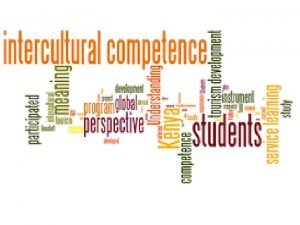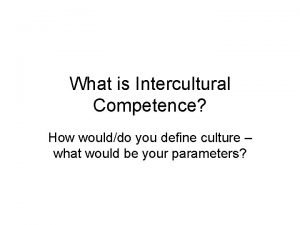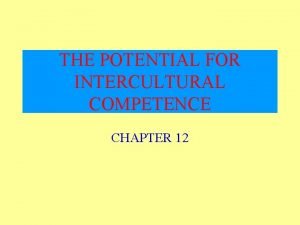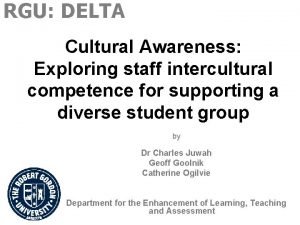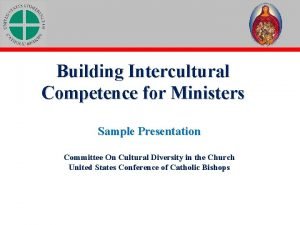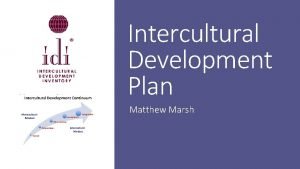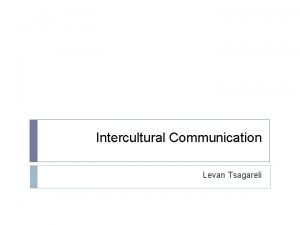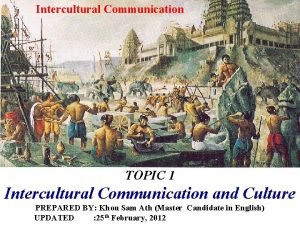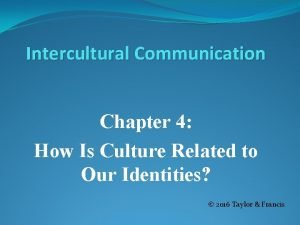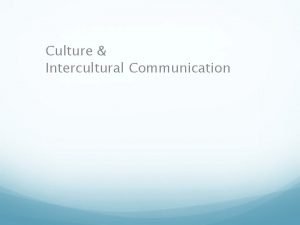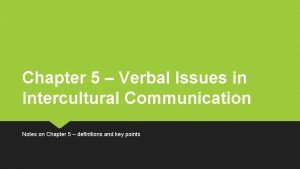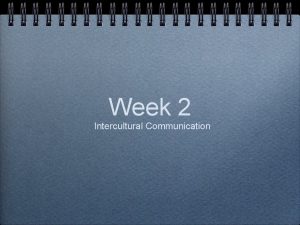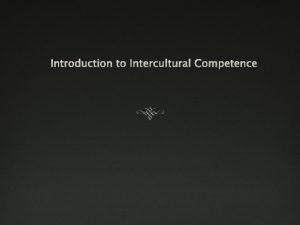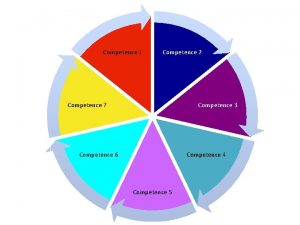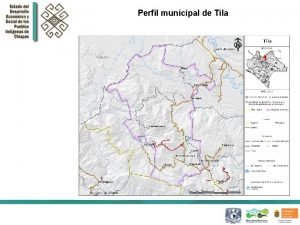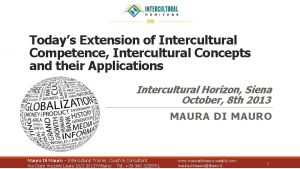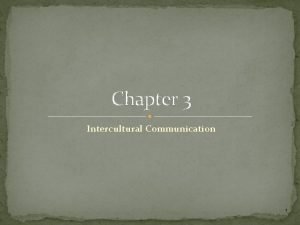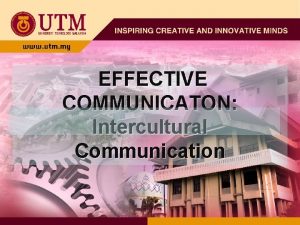Tila Teacher Training Intercultural Communication and Competence Development





















- Slides: 21

Tila Teacher Training Intercultural Communication and Competence Development © 2013 TILA Kurt Kohn & Petra Hoffstaedter - STZ Sprachlernmedien 1

Overview Discussion of background concepts and their relevance for intercultural communication and language learning: � Understanding culture � Challenges for successful intercultural communication � Theoretical models of competence and what they help us understand � Being able to communicate in intercultural contexts © 2013 TILA Intercultural communication and competence development 2

Understanding culture © 2013 TILA Intercultural communication and competence development 3

Models of Culture – the Onion Model Cultural artefacts Rituals and traditions Values Cultural artefacts or symbols (e. g. flags, architecture or traditional clothing) Rituals and traditions: how people greet each other, eat meals, get married or practice their religion, etc. Underlying values – beliefs, norms and attitudes (Adapted from Geert Hofstede) © 2013 TILA Intercultural communication and competence development 4

Models of Culture – the Iceberg Model Visible and obvious aspects of culture Invisible aspects of culture Also see: Edward T. Hall, Beyond Culture, Garden City, New York 1976 © 2013 TILA Intercultural communication and competence development 5

Challenges for successful intercultural communication © 2013 TILA Intercultural communication and competence development 6

Divergences and challenges Communicative success depends on how well speakers are able to cope with various communication challenges v v Cognitive divergence (cognitive challenges) by s e ed ped ergenc im be l div can viora a s is ces d beh n suc tive ional a t nica mu emo Com nitive, cog v Ø linguistic-communicative knowledge & skills: grammatical, socio-linguistic, discourse, strategic Ø requirements of performance in general and situation-specific Ø background knowledge: cultural, subject-specific, episodic, contextual Ø conceptualization of communication genres Ø conceptualization of the current communicative situation Emotional divergence (emotional challenges) Ø each speaker’s emotional (pre-)disposition Ø emotional relationship between the speakers Ø emotional attitude towards specific manifestations of cognitive forces Behavioral divergences (behavioral challenges) Ø Body language Ø General appearance © 2013 TILA Intercultural communication and competence development 7

Theoretical models of competence and what they help us understand © 2013 TILA Intercultural communication and competence development 8

Questions we should try to answer � � � Why/how do speakers from the same speech fellowship manage to understand each other? Why/how do (non-native) speakers from different speech fellowships manage to understand each other? Why/how do cognitive, emotional or behavioural factors play a role in supporting or reducing communicative success? What can the models below contribute to answering these questions? Models of linguistic and communicative competence v Chomsky 1964: Linguistic competence = an ideal speaker’s grammatical knowledge v Hymes 1972: Communicative competence = a real (native) speaker’s capabilities (knowledge and ability for use) with regard to judgements concerning possibility, appropriateness, feasibility and probability (ethnographic approach) v Canale & Swain 1980, Canale 1983: pedagogical model of communicative competence with 4 dimensions: grammatical, socio-linguistic, discourse, and strategic competence; orientation is towards native-speaker competence [also see Bachman 2001] v Leung 2005: ethnographic reconceptualization of communicative competence, i. e. back to Hymes’ focus on how speakers communicate (instead of how they should communicate) © 2013 TILA Intercultural communication and competence development 9

Chomsky’s linguistic model of grammatical competence “. . . we assume intuitive knowledge of the grammatical sentences of English and ask what sort of grammar will be able to do the job of producing these in some effective and illuminating way. We thus face the familiar task of explication of some intuitive concept – in this case, the concept ‘grammatical in English’, and more generally, the concept ‘grammatical’. ” [Chomsky 1957: 13] "Linguistic theory is concerned primarily with an ideal speaker-listener, in a completely homogeneous speech-community, who knows its language perfectly and is unaffected by such grammatically irrelevant conditions as memory limitations, distractions, shifts of attention and interest, and errors (random or characteristic) in applying his knowledge of the language in actual performance. “ [Chomsky 1964: 3] Does Chomskys’ model help us better understand how people manage to communicate? © 2013 TILA Intercultural communication and competence development 10

Hymes’ ethnographic model of communicative competence “In the linguistic theory under discussion, judgements are said to be of two kinds: of grammaticality, with respect to competence, and of acceptability, with respect to performance. ” [Hymes 1972: 281] “If an adequate theory of language users and language use is to be developed, it seems that judgements must be recognized to be in fact not of two kinds but of four. . . I would suggest, then, that for language and for other forms of communication (culture), four questions arise: 1. Whether (and to what degree) something is formally possible; 2. Whether (and to what degree) something is feasible in virtue of the means of implementation available; 3. Whether (and to what degree) something is appropriate (adequate, happy, successful) in relation to a context in which it is used and evaluated ; 4. Whether (and to what degree) something is in fact done, actually performed, and what its doing entails. ” [Hymes 1972: 281] Does Hymes’ model help us better understand how people manage to communicate? © 2013 TILA Intercultural communication and competence development 11

Hymes’ ethnographic model of communicative competence “I should take competence as the most general term for the capabilities of a person. (This choice is in the spirit, if at present against the letter, of the concern in linguistic theory for underlying capability. ) Competence is dependent upon both (tacit) knowledge and (ability for) use. Knowledge is distinct, then, both from competence (as its part) and from systemic possibility (to which its relation is an empirical matter. )” [Hymes 2972: 282] “Knowledge also is to be understood as subtending all four parameters of communication just noted. There is knowledge of each. Ability for use / also may relate to all four parameters. Certainly it may be the case that individuals differ with regard to ability to use knowledge of each: to interpret, differentiate, etc. The specification of ability for use as part of competence allows for the role of noncognitive factors, such as motivation, as partly determining competence. In speaking of competence, it is especially important not to separate cognitive from affective and volitive factors, so far as the impact of theory on educational practice is concerned; [. . . ] Within a comprehensive view of competence, considerations of the sort identified by Goffman (1967, pp. 218 -26) must be reckoned with - capacities in interaction such as courage, gameness, gallantry, composure, presence of mind, dignity, stage confidence [. . . ]” [Hymes 1972: 282/3] Does Hymes’ model help us better understand how people manage to communicate? © 2013 TILA Intercultural communication and competence development 12

Canale & Swain’s pedagogical model of communicative competence Dimensions of communicative competence (Canale & Swain 1980, Canale 1983): v grammatical competence ( “possible”) v socio-linguistic competence ( “appropriate”) v discourse competence ( “feasible”) v strategic competence “To summarize, we have so far adopted the term 'communicative competence‘ to refer to the relationship and interaction between grammatical competence, or knowledge of the rules of grammar, and sociolinguistic competence, or knowledge of the rules of language use. Communicative competence is to be distinguished from communicative performance, which is the realization of these competencies and their interaction in the actual production and comprehension of utterances (under general psychological constraints that are unique to performance). “ (Canale & Swain 1980: 6) “However, we hesitate to incorporate the notion of ability for use into our definition of communicative competence. “(Canale & Swain 1980: 7) Does Canale & Swain’s model help us understand what non-native speakers need to learn so that they are able to communicate in a second language? © 2013 TILA Intercultural communication and competence development 13

Being able to communicate in intercultural contexts © 2013 TILA Intercultural communication and competence development 14

Questions we should try to answer � Why/how do speakers from the same speech fellowship manage to understand each other? � Why/how do (non-native) speakers from different speech fellowships manage to understand each other? � Why/how do cognitive, emotional or behavioural factors play a role in supporting or reducing communicative success? Do the following perspectives on intercultural communication help to answer the questions above? © 2013 TILA Intercultural communication and competence development 15

Intercultural Communicative Competence Skills Attitudes • • • Knowledge Empathy Openness Tolerance for ambiguity Respect for otherness Behavioural flexibility • Knowledge about own culture and about other cultures • Knowledge about communication styles • Etc. [cf. Byram 1997] What is the explanatory power of Byram’s models with regard to the questions on the previous page? © 2013 TILA • Interpreting and relating • Discovery • Ability to acquire new knowledge of a culture and of cultural practices • Critical awareness - question own cultural beliefs and accept other ways of acting and thinking • Ability to use knowledge, attitudes and skills in communication and interaction And where do linguisticcommunicative skills come in? Intercultural communication and competence development 16

Linguistic-communicative competence. . . concerning my communicative-linguistic knowledge & skills � lexical and grammatical means of expression � how these can be used to fulfil language & communication-related requirements of performance cf. Hy o comprehensibility ( feasibility) me s 1 o grammatical accuracy ( possibility) 97 2 c; Ko o situational appropriateness ( acceptability, probability) hn 20 11 o participation and self expression. . . concerning my requirements of performance � a little child in first language acquisition � an immigrant in second language acquisition � an EFL learner in a lingua franca situation. . . concerning my individual and social identity orientation � Who do I want to be? → e. g. am I comfortable with myself? � What/who is my role model? → e. g. some kind of SE? � By whom do I want to be accepted? → desire for participation? © 2013 TILA Intercultural communication and competence development 17

Negotiating a ‘third space’ of intercultural ELF communication Conceptual reorientation: collaborative ‘third space’ creation instead of emulation of s. o. else’s cultural space [Kramsch 2009] v v v Learning to cope with cognitive, emotional and behavioural (CEB) divergences Ø Noticing & ascertaining, exploring, and reducing CEB divergences Ø Related linguistic/communicative means of expression and moves Ø Strategic processes of accommodation, meaning negotiation, and ‘let it pass’ Facilitating conditions Ø Empathy, tolerance of ambiguity, behavioural flexibility [Byram 1997] Ø Ability to explore and trust one’s own NNS creativity [Kohn to be publ. ] Development through communicative participation Ø Communicative interaction in authentic speech fellowships or communities of practice Ø Authentic & autonomous web-based communication & collaboration [Kohn & Warth 2011] Ø Encourage and develop a learner’s sense of OWNERSHIP [Widdowson 2003] & AGENCY to ensure speaker satisfaction and self-confidence © 2013 TILA Intercultural communication and competence development 18

Intercultural communication and everyday communication Is intercultural communication different from “ordinary” everyday communication? Cultural distance tends to increase cognitive, emotional and behavioral divergences (CEB divergences) Ø Ordinary everyday communication and intercultural communication are not different in kind. Ø To ensure communicative success, both ordinary and more specifically intercultural communication might require appropriate cooperative interventions. Cultural distance with CEB divergences can be observed in everyday communication, e. g. status, gender Intercultural communication is often characterised by special types of cognitive and emotional divergence and thus may require special cooperative interventions. © 2013 TILA Intercultural communication and competence development 19

Over to you How would you translate the insights on intercultural communicative competence into learning objectives for your students? Use the Moodle WIKI in the “Over to you” section to discuss and note down relevant learning objectives. © 2013 TILA Intercultural communication and competence development 20

References Byram, M. (1997). Teaching and Assessing Intercultural Communicative Competence. Multilingual Matters. Canale, M. & M. Swain (1980). Theoretical bases for communicative approaches to second language teaching and testing. Applied Linguistics 1 (1), 1 -47. Canale, M. (1983). From communicative competence to communicative language pedagogy. In Richards, J. & R. Schmidt (eds. ) Language and Communication. London: Longman 2 -27. ] Chomsky, N. (1957). Syntactic Structures. The Hague: Mouton. Chomsky, N. (1964). Aspects of the Theory of Syntax. Cambridge, MA: MIT Press. Hymes, D. H. (1972). On communicative competence. In Pride & Holmes, (eds. ). Sociolinguistis. Penguin, 269 -293. Kohn, K. (2011). ELF and the Standard English misunderstanding. In De Houwer & Wilton (eds. ). English in Europe Today. Sociocultural and Educational Perspectives. Amsterdam: John Benjamins, 72 -94. [download] Kohn, K. (2012). ‘My English’ - Second language learning as individual and social construction. TESOL Convention, Philadelphia, 28 -31 March 2012. [play video] Kohn, K. (to be publ. ). A pedagogical space for ELF in the English classroom. In Bayyurt and Akcan (eds. ). Current Perspectives on pedagogy for ELF. De Gruyter Mouton. [draft download] Kohn, K. & C. Warth (2011). Web Collaboration for Intercultural Language Learning. A Guide for Language Teachers, Teacher Educators and Student Teachers. MV-Wissenschaft. [download] Kramsch, C. (2009). Third culture and language education. In V. Cook (ed. ). Language Teaching and Learning. London: Continuum, 233 -254. Leung, C. (2005). Convivial communication: recontextualizing communicative competence. International Journal of Applied Linguistics 15/2, 119 -144. Swain, M. & M. Canale (1980). Theoretical bases of communicative approaches to second language teaching and testing. Applied Linguistics 1(1), 1 -45. Widdowson, H. (2003). Defining Issues in English Language Teaching. Oxford UP. © 2013 TILA Intercultural communication and competence development 21
 Interculturally competent meaning
Interculturally competent meaning Define intercultural competence
Define intercultural competence Behavioral assessment scale for intercultural competence
Behavioral assessment scale for intercultural competence Intercultural competence
Intercultural competence Building intercultural competence for ministers
Building intercultural competence for ministers Kahden suihkun vaatima tila
Kahden suihkun vaatima tila Modhu tila
Modhu tila Ano ang masasabi mo sa solar system
Ano ang masasabi mo sa solar system Technology and intercultural communication
Technology and intercultural communication Idd cpd requirements
Idd cpd requirements Intercultural development plan
Intercultural development plan Intercultural development continuum
Intercultural development continuum Intercultural development continuum
Intercultural development continuum Intercultural development continuum
Intercultural development continuum Idi example questions
Idi example questions Prejudice barrier in communication
Prejudice barrier in communication Example of a low context culture
Example of a low context culture Questions about intercultural communication
Questions about intercultural communication Ascription and avowal
Ascription and avowal Youtube intercultural communication
Youtube intercultural communication Intercultural communication notes
Intercultural communication notes Staircase model of intercultural communication
Staircase model of intercultural communication
